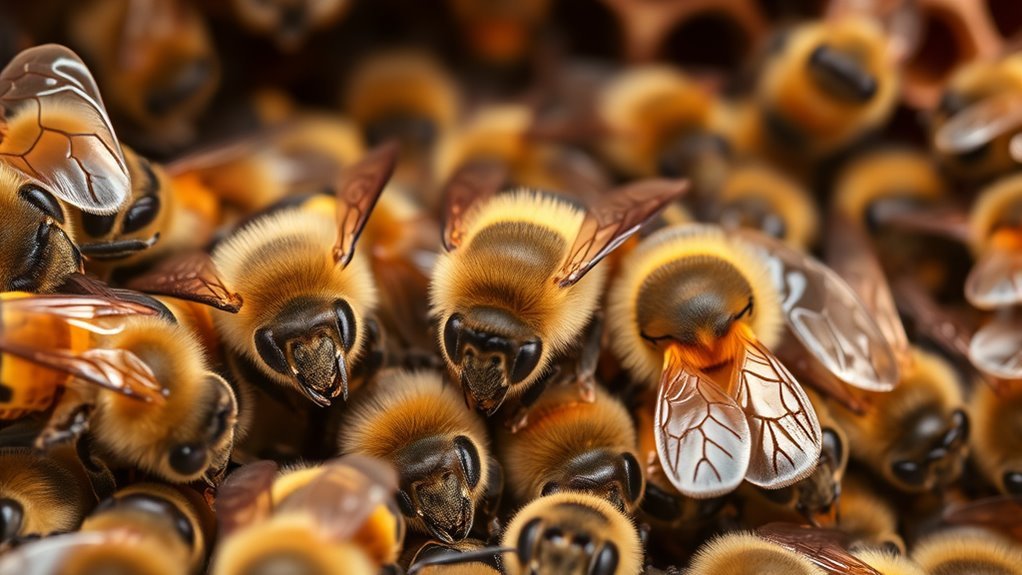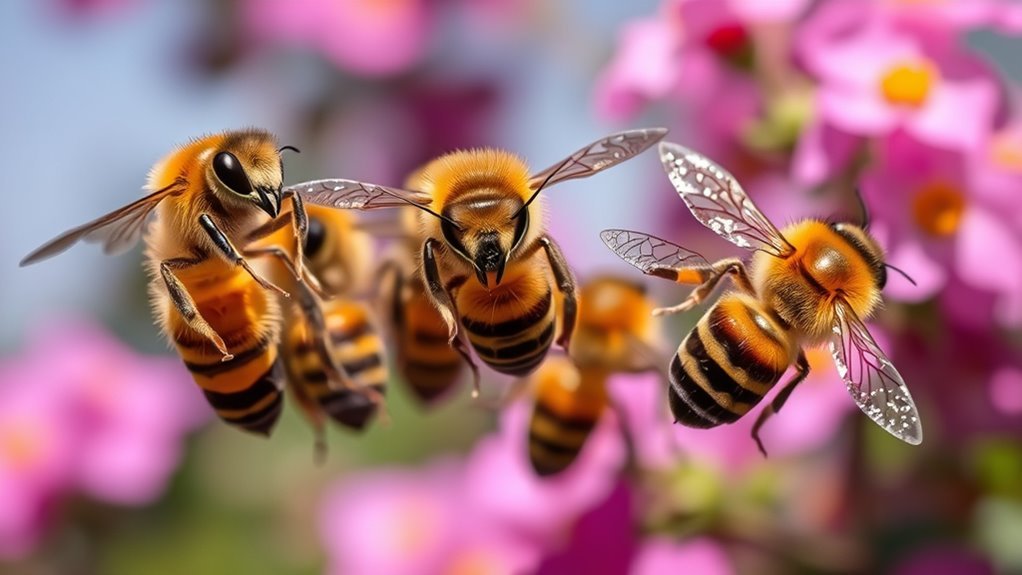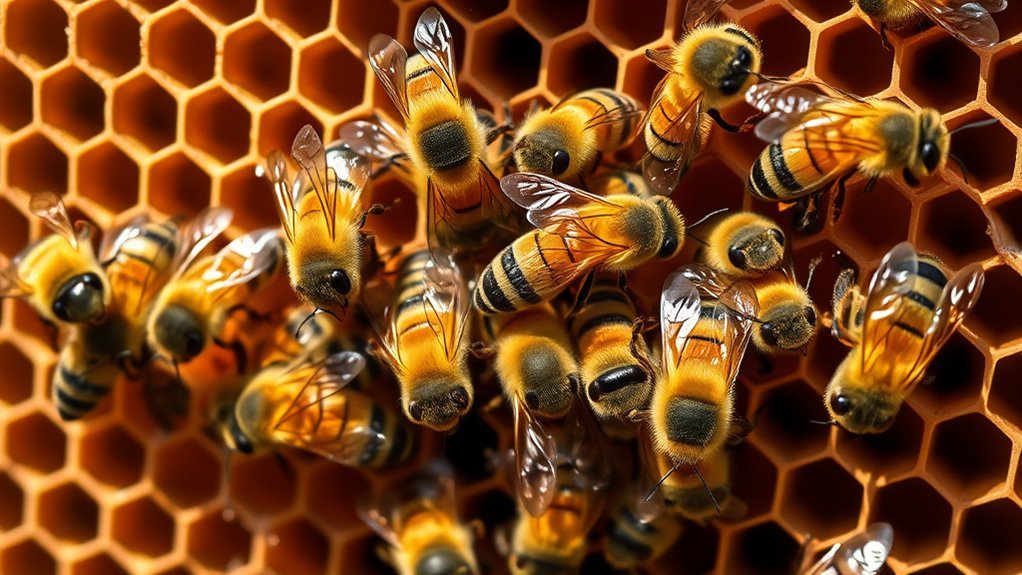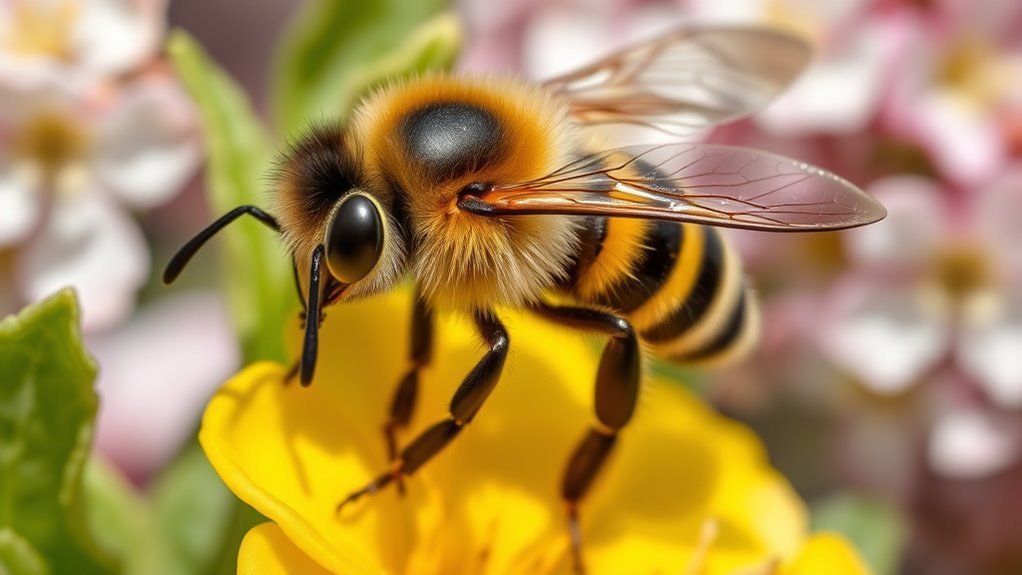To identify drone bees, look for larger insects, measuring 15-17 mm in length, with a darker coloration and broader, pronounced eyes. Unlike worker bees, drones lack stingers and focus solely on mating. Their distinctive features include longer antennae and powerful flight capabilities. Drones emerge seasonally in line with the queen’s reproductive needs, engaging in dramatic mating behaviors. Their role is critical for genetic diversity within the hive, and there’s much more to explore regarding their fascinating life cycle and behavior.
Understanding the Role of Drone Bees in the Hive

Understanding the role of drone bees in the hive is essential for appreciating their ecological significance and reproductive function. In the intricate drone hierarchy, these male bees primarily exist for mating purposes, playing a crucial role in ensuring genetic diversity within the colony. Unlike worker bees, drones don’t engage in foraging or hive maintenance; instead, they contribute to hive dynamics by influencing the reproductive health of the queen. During the mating season, drones compete for the opportunity to mate, showcasing their importance in fostering a robust and resilient bee population. This influence extends beyond reproduction, as their presence affects the social structure and behavior of the hive, underscoring the interconnectedness of all hive members in sustaining a thriving ecosystem.
Physical Characteristics of Drone Bees

When you examine drone bees, you’ll notice their distinct size and shape, which is typically larger than that of worker bees, contributing to their unique role in reproduction. Their wing structure is also significant, as it allows for powerful flight, essential during mating flights. Additionally, the coloration and markings of drone bees can vary, often appearing darker compared to other bees, which aids in their identification within the hive.
Size and Shape
Drone bees exhibit distinct physical characteristics that set them apart from worker bees and queens. Regarding size, drones are typically larger, measuring about 15-17 mm in length. Their robust, rounded bodies reflect a unique drone anatomy designed for mating rather than labor. Unlike worker bees, drones lack stingers, emphasizing their non-defensive role within hive dynamics. The broader, more pronounced eyes of drones facilitate locating queens during mating flights. This distinctive shape, combined with their heftier build, allows drones to navigate effectively in the open air while seeking potential mates. Understanding these physical traits is essential for identifying drone bees and appreciating their specific functions within the colony. Recognizing these differences can enhance your understanding of bee behavior and ecology.
Wing Structure
The wing structure of drone bees plays an important role in their ability to perform mating flights. Their wings exhibit unique wing anatomy that supports efficient flight dynamics, allowing them to navigate complex environments during mating season.
| Feature | Description |
|---|---|
| Wing Size | Drone wings are larger than those of worker bees, enhancing lift. |
| Wing Shape | Broad and elongated wings enable stable flight patterns. |
| Wing Movement | Flexible wing joints allow for rapid changes in flight direction. |
These characteristics guarantee that drone bees can cover significant distances and engage effectively with queens. Understanding this wing structure is vital for recognizing their role in the beehive’s reproductive success and the overall health of bee populations.
Coloration and Markings
Although often overlooked, coloration and markings are crucial to identifying drone bees and understanding their role within the hive. Drones typically exhibit a distinct drone coloration, which can range from dark brown to almost black. This darker hue sets them apart from worker bees, who tend to have lighter stripes. Additionally, drone markings may include less pronounced bands, contributing to their unique appearance. Observing these features can help you differentiate drones from other bees, especially during mating seasons when swarm behavior is common. Recognizing these subtle yet significant traits enriches your knowledge of drone biology and hive dynamics, allowing for a deeper appreciation of their critical contributions to the bee community.
Comparing Drones to Worker Bees

When you observe drone bees and worker bees, you’ll notice distinct physical differences, such as size and body structure. Drones are larger and lack the stinger, which highlights their unique role within the hive. Additionally, their behavioral traits and reproductive functions contrast sharply with those of worker bees, emphasizing the specialization in their respective roles.
Physical Appearance Differences
Drones, the male members of a honeybee colony, exhibit distinct physical characteristics that set them apart from worker bees. Understanding drone anatomy can aid in visual identification, allowing you to spot these essential bees with ease. Here are four key differences:
- Size: Drones are typically larger than worker bees, with a more robust body.
- Eyes: They possess larger, rounder eyes, which help them in mating flights.
- Antennae: Drones have longer antennae, enhancing their sensory perception.
- Stinger: Unlike workers, drones lack a stinger, making them harmless.
Behavioral Traits Comparison
While worker bees are known for their industrious roles within the hive, drones exhibit distinctly different behavioral traits that reflect their primary purpose of mating. Drones engage minimally in hive interactions compared to workers, focusing primarily on drone communication when the time for mating approaches. They rely on pheromones and visual signals to locate potential mates. In contrast, worker bees are the backbone of hive activities, including foraging and maintaining hive health.
| Trait | Drones | Worker Bees |
|---|---|---|
| Primary Role | Mating | Foraging and nurturing |
| Hive Interaction | Minimal | High |
| Communication Style | Pheromonal signals | Complex dances |
| Aggression Level | Low | High (defense) |
| Lifespan | Short (weeks) | Longer (months) |
Reproductive Roles Explained
In the complex social structure of a bee colony, the reproductive roles of drones and worker bees highlight their differing contributions to the hive’s survival and continuation. Here’s a breakdown of their roles:
- Drones: Their primary function is to mate with a queen, ensuring genetic diversity.
- Worker Bees: They focus on foraging, nursing, and hive maintenance, supporting the colony’s daily operations.
- Reproductive Cycles: Drones emerge in spring, peaking during mating season, while worker bees have a continuous cycle of reproduction and care.
- Survival Impact: Drones’ roles are essential for genetic health, while workers maintain the colony’s infrastructure, illustrating a symbiotic relationship.
Understanding these drone bee roles clarifies the intricate dynamics of reproductive cycles within a bee colony.
The Life Cycle of a Drone Bee
Understanding the life cycle of a drone bee reveals the intricate processes that govern their development and role within the hive. Drone development begins when a fertilized egg is laid in a specially prepared cell, where it transforms into a larva. Over approximately six days, the larva feeds on royal jelly and pollen, undergoing significant growth. Once it pupates, the transformation into an adult drone takes about 14 days. After emerging, drones have a lifespan of around eight weeks, primarily spent mating or waiting for their opportunity to do so. Their limited lifespan emphasizes the urgency of their role in reproduction, making it essential for them to quickly integrate into the hive’s dynamics and contribute to the colony’s genetic diversity.
The Mating Process of Drones
After emerging from their pupal stage, drones are immediately focused on one primary task: mating. This process is essential for the continuation of the hive and involves several intricate mating rituals. During their brief mating window, drones engage in fierce drone competition to attract a queen. Here’s how it unfolds:
Drones emerge with a singular purpose: to mate, ensuring the hive’s survival through intense competition and elaborate rituals.
- Mating Flights: Drones take to the skies, often congregating in specific areas known as drone congregation areas.
- Scent Marking: They utilize pheromones to signal their readiness and attract potential queens.
- Physical Competition: Only the most vigorous drones succeed; they must outmaneuver rivals.
- Copulation: Successful drones mate mid-air, transferring sperm before falling to the ground, often leading to their demise.
This elaborate process underscores the urgency and intensity of their reproductive role.
The Importance of Drones for Queen Breeding
While many might overlook their role, drones are indispensable for the breeding of queens within the hive. Their primary function revolves around drone mating, where genetic diversity is essential for a healthy colony. When a queen emerges, she engages in a selective process, choosing drones based on their fitness and genetic traits. This selection guarantees robust offspring, promoting resilience against diseases and environmental changes.
| Trait | Importance | Impact on Colony |
|---|---|---|
| Genetic Diversity | Enhances adaptability | Resilience to diseases |
| Drone Fitness | Secures strong offspring | Healthy colony dynamics |
| Mating Success | Increases queen’s reproductive efficiency | Greater hive productivity |
Understanding this intricate relationship highlights the critical role drones play in sustaining the hive’s future.
Seasonal Presence of Drone Bees
As temperatures rise and the days lengthen in spring, the presence of drone bees becomes increasingly pronounced within the hive. This seasonal activity correlates with drone emergence, which plays a crucial role in the reproductive cycle of honeybees. You can expect to observe the following patterns:
- Increased drone production as the queen begins laying eggs.
- Drones typically emerge in late spring, aligning with flowering plants.
- Their population peaks in summer, coinciding with the hive’s reproductive needs.
- By late summer or fall, many drones are expelled from the hive as resources dwindle.
Understanding these patterns can enhance your knowledge of hive dynamics and the fundamental role drones play in sustaining the colony’s future.
Observing Drone Behavior in the Hive
The increased presence of drone bees in the hive during the warmer months offers a unique opportunity to observe their behavior and social interactions. You’ll notice drones engaging in various hive interactions, especially during drone flight periods. These flights serve critical roles in mating rituals and establishing hierarchies within the hive.
| Behavior | Description | Observational Notes |
|---|---|---|
| Drone Flight | Mating flights outside the hive | Usually occurs on warm days |
| Social Grooming | Mutual grooming among drones | Enhances colony cohesion |
| Resource Sharing | Drones partake in nectar sharing | Important for hive health |
| Vigilance | Drones monitor hive activity | Helps protect the colony |
Understanding these behaviors can deepen your appreciation for these essential hive members.
Frequently Asked Questions
How Do Drone Bees Communicate With Each Other?
Drone bees communicate primarily through pheromones, essential for coordinating mating rituals. Their drone behavior includes visual cues and vibrations, helping them identify potential mates during nuptial flights, fostering genetic diversity within the hive’s population.
What Predators Threaten Drone Bees?
Drone bee predators include birds, wasps, and various insects that pose natural threats to their survival. You’ll find these predators often target drone bees during mating flights, considerably impacting their populations and overall hive dynamics.
Can Drone Bees Sting Humans?
You might be surprised to learn that drone bees can’t sting humans. Their anatomy lacks the stinger, a feature typical of worker bees. Understanding their behavior reveals they’re more focused on reproduction than defense.
How Long Do Drone Bees Typically Live?
Drone bees typically have a short lifespan, averaging 8 weeks. Their primary role revolves around bee reproduction, mating with queens. After fulfilling this purpose, drones often die, emphasizing their brief but essential existence in the hive.
What Do Drone Bees Eat?
Drone bees primarily rely on pollen consumption for their nutrition. They digest proteins and fats from pollen, which supports their development and energy needs, ensuring they can fulfill their role within the hive efficiently.

